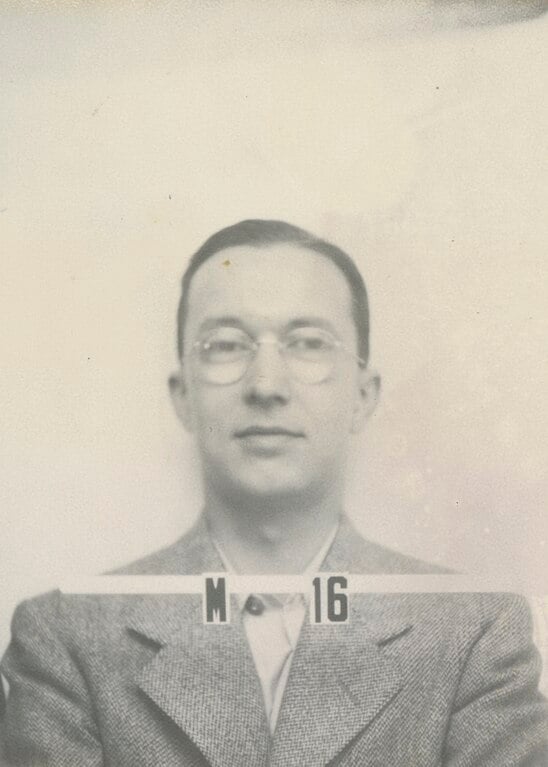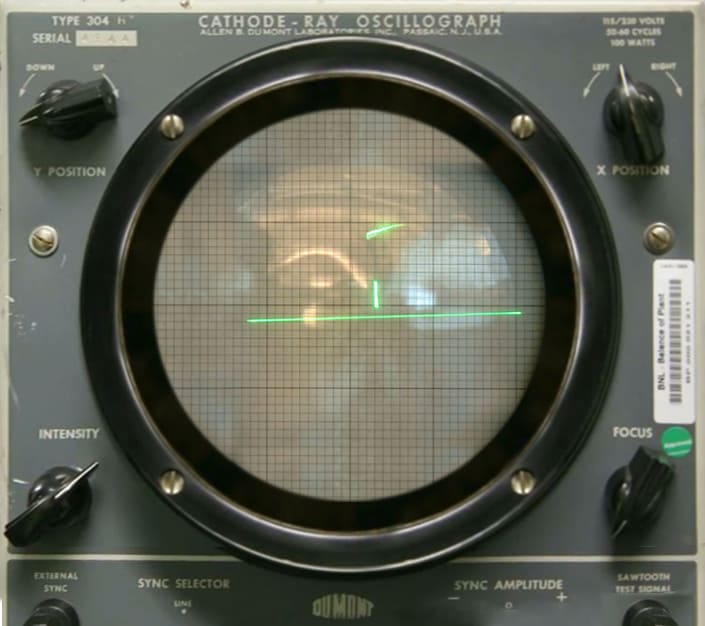Key Points:
- William Higinbotham created the first computer video game to display motion and allow interactive control with hand-held controllers. It was dubbed “Tennis for Two.”
- Besides the first video game, Higinbotham led the development of the radar devices used in World War II and the design components for the first atomic bomb.
- Although Higinbotham didn’t patent “Tennis for Two,” he obtained over 20 other patents during his career.

William Alfred Higinbotham was an
American physicist and inventor of “Tennis for Two.”©Los Alamos Laboratory, Attribution, via Wikimedia Commons – Original / License
Who was William Alfred Higinbotham?
William (Willy) Alfred Higinbotham was an American physicist who is credited with creating the first computer video game to display motion and allow interactive control with hand-held controllers in 1958. Known as “Tennis for Two,” it was the first interactive analog computer game and one of the first electronic games to use a graphical display.
He was a member of the team that developed the first nuclear bomb; he later became a leader in the nonproliferation movement.
Quick Facts
- Full Name
- William Higinbotham
- Birth
- October 22, 1910
- Death
- November 10, 1994
- Net Worth
- $1M-$5M
- Awards
- Honorary doctorate in science, Williams College, 1963
- Fellow of the American Physical Society, IEEE, and the American Association for the Advancement of Science (AAAS)
- Distinguished Service Award, Institute of Nuclear Material Management (INNM), 1979
- IEEE Annual Nuclear Science Award, 1971
- Children
- Julie, Robin and William B.
- Nationality
- American
- Place of Birth
- Bridgeport, Connecticut
- Fields of Expertise
- [“Physics”,”Nuclear Weapons”]
- Institutions
- M.I.T., Los Alamos National Laboratory, Brookhaven National Laboratory
- Contributions
- Eagle Radar, Work on Manhattan Project, Tennis for Two, Federation of American Scientists
Early life
Higinbotham was born in Bridgeport, Connecticut, and grew up in Caledonia, New York. He was raised by Reverend Robert G. and Dorothea Higinbotham. His father was a minister for the First Presbyterian Church in Caledonia, a small town in southwest Rochester. William’s interest in science peaked at the age of 14. He began constructing and dismantling radios. He wanted to pick up the frequency transmission of the first commercial radio stations. When he was 16, Higinbotham enrolled in a physics class and discovered that he was a natural. In 1932, Higinbotham earned his undergraduate degree in physics from Williams College and continued his studies at Cornell University.
Career
William Higinbotham was a scientist who specialized in physics and nuclear weaponry. He is recognized for leading the development of the radar devices used in World War II, the design components for the first atomic bomb, and the first video game. Higinbotham is often associated with the Federation of Atomic Scientists and the Journal of Nuclear Material Management, which was published by the Institute of Nuclear Materials Management. Here are some additional career highlights.
Massachusetts Institute of Technology
During World War II, Robert Fox Bacher was pursuing post-doctoral studies at Massachusetts Institute of Technology, in 1941 he invited Higinbotham to join MIT’s Radiation Laboratory to research and develop radio detecting and ranging (radar) devices for application during World War II. This lasted from 1941 to 1943.
Los Alamos National Laboratory
Higinbotham and Bacher’s professional relationship continued for several more years. Bacher recruited Higinbotham in 1943 to Los Alamos National Laboratory in New Mexico. In 1944, he became the head of the lab’s electronics group and worked on a classified military assignment- to research and develop design components for the first atomic bomb as part of the Manhattan District Project. His team created the bomb’s ignition mechanism and the measuring instrument for the device. Higinbotham was allowed to visit the test site and on July 16, 1945, he and his colleagues witnessed the test detonation of the first atomic bomb. Less than a month later, the atomic bomb dropped on Hiroshima and Nagasaki. Higinbotham was appointed chairman of the Association of Los Alamos Scientists a few days later.
Federation of American Scientists
Upon witnessing the test of the atomic bomb and seeing its effects in Hiroshima and Nagasaki, Higinbotham left Los Alamos and was eager to share his convictions about nuclear non-proliferation.
With Higinbotham’s experience in nuclear weapons, he helped found the nuclear nonproliferation group the Federation of Atomic Scientists on November 1, 1945. This group was formed to address the issues, implications, and consequences of scientific endeavors on the combat community. In December, they expanded membership and renamed the group the Federation of American Scientists (FAS). Higinbotham moved to Washington, D.C., and served as the first executive director and chairman.
Brookhaven National Laboratory
In 1947 Higinbotham took a position at the Brookhaven National Laboratory in Upton, New York. He was offered the Physics Department’s associate division chief position in experimental nuclear electronic instrumentation. Higinbotham was interested in the Brookhaven National Laboratory because of its focus on responsible and peaceful uses of nuclear power. At the end of 1948, he received a series of promotions and achieved tenure. In 1952 Higinbotham was appointed the division head of the Instrumentation and Health Physics Department. It was during this time that “Tennis for Two” was introduced during the 1958 annual Visitors Day. He would hold this position for 17 years.
From 1974 until he died in 1994, Higinbotham was a technical editor for the Journal of Nuclear Material Management which was published by the Institute of Nuclear Materials Management.
What is Higinbotham known for?
Radar
While at M.I.T., Higinbotham researched and developed radio-detecting and ranging (radar) devices for application during World War II. During this time, analog computers were being developed and adapted for military initiatives, primarily for simulations. Higinbotham designed displays using cathode-ray tubes, or CRTs. Among the many initiatives that Higinbotham worked on, one was a joint project with Bell Laboratories to develop the Eagle Radar, a high-altitude bombing system. He designed the indicator’s subsystem.
Atomic Bomb
In 1943 when Higinbotham first arrived at Los Alamos, he found that the electronics were outdated compared to M.I.T. He built triggered sweeps for the oscilloscopes, fast amplifiers, and low-capacity probes. At Los Alamos, Higginbotham worked on a classified military assignment to research and develop design components for the first atomic bomb. Higinbotham and his team worked on electronic amplifiers, counters, and recorders for the atomic bomb. They developed the timing circuits that would control the bomb before detonation.
Federation of American Scientists
As a member of the Federation of American Scientists, their activities included lobbying, educational lectures, producing the Bulletin of Atomic Scientists, and testifying at official government hearings.
A major success of the Federation of American Scientists was the defeat of the May-Johnson Bill and the passage of the McMohan/Atomic Energy Act of 1945.
The May-Johnson Bill l would have given control of nuclear research to the military. The Atomic Energy Act established the US Atomic Energy Commission, a civilian commission under which atomic energy policy and nuclear power development were managed.
Tennis for Two
In 1958, the Laboratory organized its annual Visitors Days. That’s when Higinbotham realized how static most science exhibits were. Higinbotham wanted to add some entertainment to the exhibit, so in two weeks with the help of two colleagues – David Potter and Robert Dvork Sr. they created a game – “Tennis for Two.”
It was designed to look like a tennis court and allowed players to control a movable ball seen on a screen, similar to a modern video game.
The game was a popular attraction at the exposition, and Higinbotham expanded the version for the 1959 exposition.
This was the final appearance of “Tennis for Two” and Higginbotham went on to pursue other scientific endeavors. Although Higinbotham never patented “Tennis for Two,” he obtained over 20 other patents during his career.
Higinbotham: Marriage, children, and personal life
Net Worth
Between $1 Million — $5 Million
Marriage
Higinbotham married Julie Ann Burritt on June 9, 1949.
Children
He and Julie Ann Burritt had three children: Julie, Robin, and William B.
Higinbotham: Awards and Achievements
- Honorary doctorate in science, Williams College, 1963
- IEEE Annual Nuclear Science Award, 1971
- Distinguished Service Award, Institute of Nuclear Material Management (INNM), 1979
- Fellow of the American Physical Society, IEEE, and the American Association for the Advancement of Science (AAAS).

©Brookhaven National Laboratory (BNL), Public domain, via Wikimedia Commons – Original / License
The image featured at the top of this post is ©Los Alamos Laboratory, Attribution, via Wikimedia Commons – License / Original

